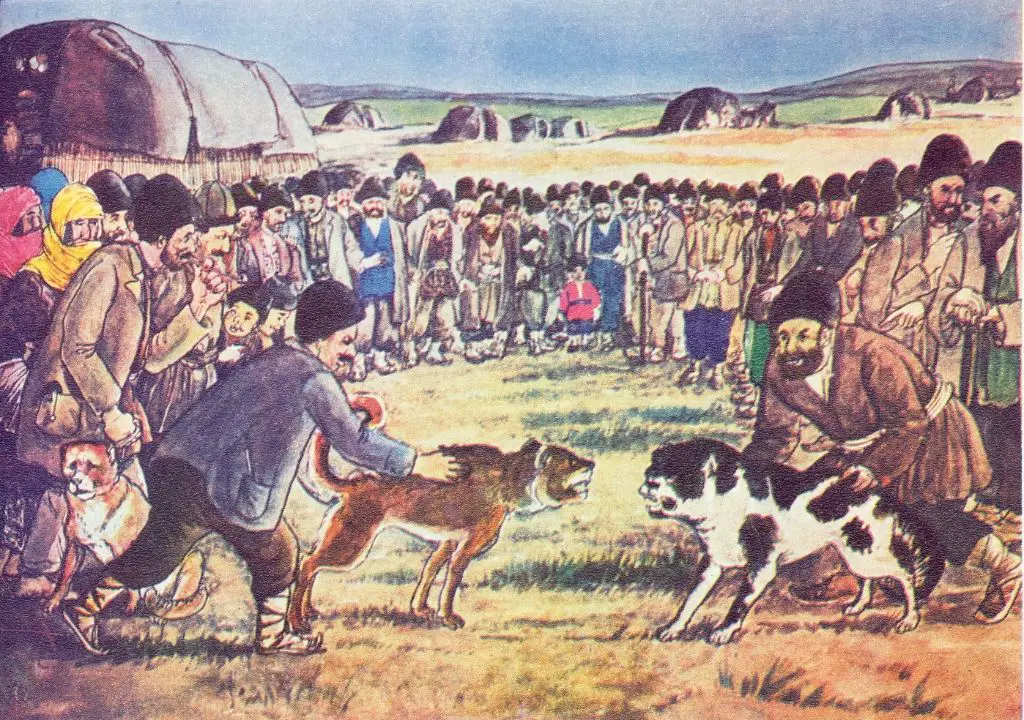Introduction
Dogfighting has a long history dating back thousands of years. Various breeds have historically been used in dog fighting around the world, including bulldogs in England and terriers in Ireland. However, pit bulls have become the breed most commonly associated with dogfighting in modern times.
Pit bulls were originally bred in England in the 19th century for the cruel blood sport of bull baiting, in which dogs were set upon chained bulls as a form of entertainment. When bull baiting was outlawed in 1835, the dogs were then used for organized dog fighting. Pit bulls were favored for their muscular build, strong bite, and unwavering tenacity when attacking other dogs.
When pit bulls came to the United States in the late 19th century, dogfighting grew in popularity in many areas. High-stakes dog fights were organized by crime syndicates and others looking to profit from the violent contests. Despite periodic crackdowns, dogfighting rings have persisted as an underground activity to this day.

Pitbull Breed Traits
Pitbulls possess several inherent physical and temperamental traits that make them appealing for exploitation in dog fighting. They have a stocky, muscular build and strong, powerful jaws that give them an advantage in combat. Their ancestors were originally bred for bull baiting and dog fighting, so they have been selectively bred for gameness and aggression.
One of the key traits that make pitbulls attractive for dog fighting is their physical strength and stamina. They have a very muscular physique, especially in the chest, neck and jaw area. Their muscles generate a tremendous amount of pulling power and biting force. This enables them to overpower other dogs and inflict significant damage with their bites. Pitbulls also have a high pain tolerance and stubborn determination to continue fighting even when injured.
In addition, pitbulls have exceptional endurance and persistence. They can remain actively engaged in a fight for prolonged periods without tiring or giving up. Even when exhausted, pitbulls display a high drive to keep attacking their opponent. This stamina and persistence allow them to wear down other dogs during long, grueling fights.
Ease of Obtaining Pitbulls
Pitbulls are unfortunately an abundant and easily accessible breed for those looking to exploit them for illegal dogfighting. As one of the most popular breeds in the United States, pitbull puppies are readily available through both reputable and disreputable breeders. Their popularity also leads to overbreeding by irresponsible breeders and owners, resulting in many pitbulls ending up in shelters. This provides easy access to the breed for dogfighters, who can easily adopt or buy pitbulls locally.
The abundance and availability of pitbulls makes it simple for those involved in dogfighting to obtain all the dogs they need. Unlike rare or expensive breeds that are more difficult to acquire in large numbers, pitbulls are plentiful in most areas. This unfortunately provides dogfighters with a relatively low-cost and convenient way to source fighting dogs in whatever quantity they require.
Training Pitbulls to Fight
Unfortunately, some owners train pitbulls to be aggressive and use them for the illegal act of dogfighting. There are various cruel methods used to try to increase their aggression and make them willing to fight other dogs:

– Physical abuse like beating or whipping
– Forcing them to run on treadmills for long periods
– Feeding them gunpowder or other substances
– Having them wear weighted collars to strengthen their necks and jaws
– Tying weights to their legs for resistance training
– Forcing them to pull heavy objects like tires or chains
– Making them wear scratch pants to irritate their skin before fights
– Baiting them with other animals like cats to encourage prey drive
These cruel training methods are tragically used to try to transform naturally sweet-tempered pitbulls into aggressive fighters. However, animal experts agree pitbulls are not inherently dangerous, and their reputation is often unfairly shaped by those who exploit and abuse them.
Fight Performance
Pitbulls are prized for their fighting abilities due to traits like gameness and strong bite strength. Gameness refers to a dog’s willingness to continue fighting, even in the face of injury or exhaustion. Pitbulls have been selectively bred for this trait, allowing them to keep fighting despite sustaining wounds that would stop other dogs. Their bite strength also gives them an advantage in the fighting pit. Studies have shown that pitbulls have one of the strongest bite forces among dog breeds, allowing them to inflict significant damage on opponents. Their powerful jaws and muscular build allow them to bite down hard and grip tenaciously, making it difficult for opponents to break free. These inherent traits make pitbulls formidable fighters, able to sustain fights longer while dishing out damaging bites. Their combination of gameness and strength helps explain why they are sought after for illegal dog fighting operations.
Profitability of Dog Fighting
For those involved in the underground world of dog fighting, there is significant money to be made through betting on the fights and stud fees for champion fighters used for breeding. Betting on dog fights offers the opportunity for quick financial gain or loss, fueling the appeal for some participants. Bets can range from a few dollars between spectators to thousands of dollars between dog owners and fight organizers. The high stakes make fights more exciting and incentivize owners to invest in training and breeding winning dogs.

Stud fees collected from breeding champion fighting dogs can also be a lucrative source of revenue. Owners of champion fighters can charge anywhere from a few hundred to a few thousand dollars to breed their dog. The pups of champion fighters are highly sought after and the stud fees provide a relatively passive income stream for dog fighting operations. This financial incentive fuels the continued breeding of dogs for fighting purposes.
While clearly unethical and illegal, the betting and stud fees make dog fighting a profitable underground activity. The significant sums of money that can be generated through gambling, breeding, and changing hands within the dog fighting community entice participation in this inhumane blood sport.
Difficulty of Detecting Dog Fighting Operations
Dog fighting rings can be immensely difficult for law enforcement to detect because the organizers intentionally keep fighting operations well-hidden due to the illegal nature of the activity. Fighting rings are typically held in private, indoor locations like basements, barns or warehouses, away from the public. Organizers avoid any publicity or promotion that might reveal fights are taking place.
Fights themselves are conducted at night or in the very early morning to avoid being noticed. Only trusted participants are told the time and place. The secluded venues allow organizers to quickly hide or destroy any evidence if police were to arrive without warning. The fights are over in less than an hour, with the dogs removed immediately afterwards.
With little noise, light or traffic at the venues, neighbors, passerbys and even police patrolling the area tend not to notice any unusual activity. Law enforcement generally has to receive a specific tip off from an informant in order to become aware of the existence of a fighting ring and obtain the time and location of an event.
Weak Enforcement of Laws
Dog fighting is illegal in all 50 states and the District of Columbia. However, the laws are notoriously difficult to enforce for a variety of reasons. A major challenge is that professional dog fighters go to great lengths to avoid detection. Fights are held in secret locations that shift frequently, spectators are carefully selected, and communication is done covertly. This makes it extremely difficult for law enforcement to infiltrate rings and gather solid evidence needed for prosecution.

Even when raids occur and dogs are seized, the legal cases are often dismissed due to lack of evidence or lenient sentences. Building a strong case requires catching dog fighters “in the act,” which rarely happens. Eyewitness testimony from informants also tends to be unreliable. Since dog fighting is a tightly knit underground culture, people are unwilling to turn on each other out of fear of retaliation.
The result is that few cases make it to trial, and those that do often end in plea bargains for lesser charges. Light sentencing also fails to deter dog fighters. The current laws are not strong enough to offset the huge profits gained from staging fights. For law enforcement, shutting down dog fighting rings remains an uphill battle as long as the cultural attitudes and financial incentives remain.
Culture and Traditions
In certain parts of the world, dog fighting is an accepted part of the culture. It has a long history and tradition in some communities. For example, in parts of Afghanistan, Pakistan, and Central America, dog fighting is a popular pastime that has been passed down through generations. Many view it simply as entertainment.
These cultural roots make the practice hard to eliminate, despite it being illegal in most places. Some argue that dog fighting is part of their heritage and attempts to ban it are cultural imperialism. However, international animal welfare standards generally condemn any practices that cause unnecessary suffering to animals for recreation or profit. There are debates around respecting cultural differences versus upholding ethical principles.
Conclusion
In summary, there are several reasons why pitbulls are used for dog fighting. The key reasons are pitbull traits and breeding, the high availability and low cost of pitbull puppies, the ability to train them to fight, their performance in fights, the potential profits from gambling on dog fights, the difficulty of detecting organized fights, weak enforcement of anti-dogfighting laws, and cultural and traditional attachments to dog fighting in some communities. While this cruel bloodsport persists, the best way to combat it is through education, enforcement of laws, and promoting more positive outlets for pitbulls as loving family pets and service dogs. With vigilance and compassion, the practice of dog fighting can be eliminated.